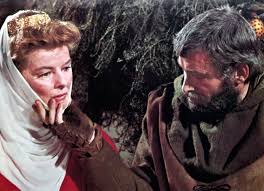Peter O’Toole and Katharine Hepburn are a knockout of a performing couple in this epic stage production turned motion picture that enthralls us in their royal problems around the Christmas season. O’Toole proves in this performance as Henry II that “Lawrence of Arabia” (1962) was not his high-point in his career. His persona as the arrogant and indecisive king of England really showed us that he was absorbed in his role. It’s quite fascinating that he played this same role as Henry II in “Beckett” (1964) opposite of Richard Burton. It may be a stretch to say this, but “The Lion in Winter” is pretty much a sequel. Hepburn is so convincing as Eleanor of Aquitaine that she just resonates whenever she pries into her husband’s and sons’ business and seduces everyone she comes in contact with. She’s really good at it. And to top it off Anthony Hopkins makes his film debut as Richard The Lionheart who is one out of three sons who wants the throne of England. I just love Richard and John are in the same movie and there’s no Robin Hood! Terrific!
One of the best things about this film is how well it adapted from the stage to motion picture. James Goldman who wrote both the play and the screenplay of this film makes this film so easy to watch. Sometimes an adaptation doesn’t go through the weeds all too well and gets roughed up a bit losing it’s authenticity and personality. Not with this film. Every scene is prepared, every bit of dialogue ignites the actor, and the tension is all too real. A husband imprisoning his wife. A knife fight between a father and son. The same husband making his mistress and wife sit at the same table. Unannounced and forced marriages. This makes my own family Christmas get-togethers look not all that bad. Perhaps there’s hope after all.









